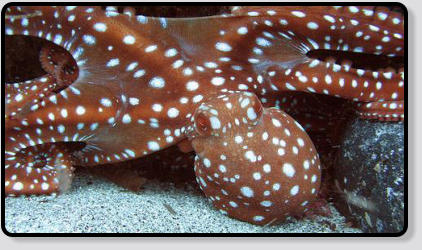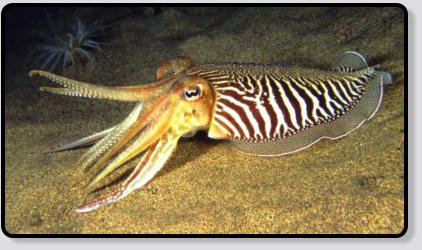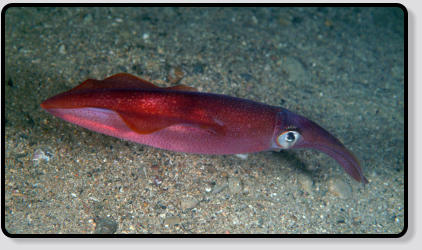Scientific classification
Kingdom:
Phylum:
Mollusca
Class:
Cephalopoda
Order:
Octopoda
Family:
Octopodidae
Genus:
Octopus
Species:
O. Vulgaris
Binomial name (link Wikipedia)




Common Octopus
Poulpe Commun
Gemeiner Krake
Pulpo
Gewone Octopus

Description
The common octopus (Octopus vulgaris) is a mollusc belonging to the class Cephalopoda. The animal belongs to the Superphylum
Lophotrochozoa, being considered a protostome and having thus a coelom. Octopus vulgaris is the most studied of all octopus species.
O. vulgaris grows to 25 cm in mantle length with arms up to 1 m long. O. vulgaris is caught by bottom trawls on a huge scale off the northwestern
coast of Africa. More than 20,000 tonnes are harvested annually.
O. vulgaris is considered cosmopolitan. Global in its range in the eastern Atlantic extends from the Mediterranean Sea and the southern coast of
England to at least Senegal in Africa. It also occurs off the Azores, Canary Islands, and Cape Verde Islands. The species is also common in the
Western Atlantic.

Animalia
Scientific classification
Kingdom:
Phylum:
Mollusca
Class:
Cephalopoda
Order:
Octopoda
Family:
Octopodidae
Genus:
Octopus
Species:
O. Macropus
Binomial name (link Wikipedia)




White-Spotted Octopus
Octopus Macropus
Langarmiger Krake
Fabiana - Pabiana
Witgestipte Octopus

Description
Callistoctopus macropus, also known as the Atlantic white-spotted octopus, white-spotted octopus, grass octopus or grass scuttle, is a species of
octopus found in shallow areas of the Mediterranean Sea, the warmer parts of the eastern and western Atlantic Ocean, the Caribbean Sea, and
the IndoPacific region. This octopus feeds on small organisms which lurk among the branches of corals.
Callistoctopus macropus grows to a mantle length of 20 cm (8 in) with a total length of 150 cm (59 in). The first pair of arms are a metre or so
long, and are much longer than the remaining three pairs. The arms are all connected by a shallow web. This octopus is red, with white blotches
on its body, and paired white spots on its arms. When it is disturbed, its colour becomes more intense, deimatic behaviour which may make it
appear threatening to a potential predator.
Populations of Callistoctopus macropus form a species complex found in the Mediterranean Sea, the temperate and tropical Atlantic Ocean and
the Caribbean Sea. It is also present in the Pacific and Indian Oceans. It lives near the shore at depths down to about 17 m (56 ft). Its favoured
habitat is sand, rubble or seagrass meadows, and it sometimes buries itself under the sand.
Animalia
Scientific classification
Kingdom:
Phylum:
Mollusca
Class:
Cephalopoda
Order:
Sepiida
Family:
Sepiidae
Genus:
Sepia
Species:
S. Officinalis
Binomial name (link Wikipedia)




Common Cuttlefisch
Seiche
Gemeiner Tintenfisch
Choco
Gewone zeekat

Description
The common cuttlefish or European common cuttlefish (Sepia officinalis) is one of the largest and best-known cuttlefish species. It grows to 49
cm in mantle length (ML) and 4 kg in weight. Animals from subtropical seas are smaller and rarely exceed 30 cm in ML.
The common cuttlefish is native to at least the Mediterranean Sea, North Sea, and Baltic Sea, although subspecies have been proposed as far
south as South Africa. It lives on sand and mud seabeds to a depth of around 200 m. As in most cuttlefish species, spawning occurs in shallow
waters.
Known predators of S. officinalis include large fish (such as monkfish and swordfish, Xiphias gladius) and whales.
In the wild, S. officinalis is known to prey upon a wide variety of animals. These include: bony fishes, copepods, crustaceans (including Astacus
leptodactylus, Carcinus sp., Crangon sp., Daphnia sp., Gammarus sp., Mugil sp., Mysis sp., Penaeus sp., Praunus sp., Sphaeroma sp., Squilla
sp.), decapod cephalopods, gastropods, lamellibranches, nemerteans, octopods, ostracods, polychaetes, and pteropods.
A 2008 study on S. officinalis revealed that cuttlefish embryos, if visually exposed to a certain species of prey (e.g. crabs), will hunt primarily for
that prey in later life. S. officinalis usually prefer shrimp to crabs, but when the embryos were exposed to crabs and the embryos had hatched, the
young cuttlefish switched preferences and proceeded to hunt the crabs more often than the shrimp.
Animalia
Scientific classification
Kingdom:
Phylum:
Mollusca
Class:
Cephalopoda
Order:
Teuthida
Family:
Loliginidae
Genus:
Loligo
Species:
L. Vulgaris
Binomial name (link Wikipedia)




Squid
Calmar
Gewöhnlicher Kalmar
Calamar
Gewone pijlinktvis

The European squid or common squid (Loligo vulgaris) is a large squid belonging to the family Loliginidae. It occurs abundantly in coastal waters
from the North Sea to at least the west coast of Africa. This species lives from sea level to depths of 500 m (1,600 ft). Its mantle is up to 40 cm
(16 in) long. The species is extensively exploited by commercial fisheries.
Loligo reynaudii, the Cape Hope squid, was previously treated as a subspecies of L. vulgaris
The European squid has a long, moderately slender and cylindrical body. Rhomboid fins comprise two-thirds of the mantle length, though
locomotion is via jet propulsion. The posterior border is slightly concave. The head is relatively small and has large eyes which are covered with a
transparent membrane. Like almost all squid, this species has ten limbs surrounding the mouth and beak: eight are relatively short arms, and
two, which form the tentacles, are long, as they are used to catch prey. The fourth left arm of males is a hectocotylus. The European squid can
grow up to 30–40 cm in the mantle length, but more usually they are 15–25 cm long. The males are generally bigger than the females and exhibit
more rapid rates of growth.
The colour of the European squid is greyish-transparent or reddish, depending on the expansion of chromatophores in the dermis. Males have
small chromatophores on their mantle
Description
Animalia



Harry van Goor 2016
source: Wikipedia, the free encyclopedia


Categories: Sepia & Octopus



